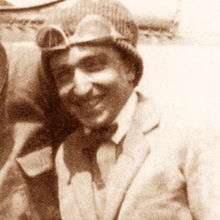Fortunato Depero
Fortunato Depero (born March 30, 1892 in Fondo , then Tyrol , Austria-Hungary , † November 29, 1960 in Rovereto ) was a versatile artist of Italian Futurism .
Life
A few years after his birth, the Depero family moved to Rovereto , where Fortunato attended the Scuola Reale Elisabettina and also received an artistic training. He presented his first work in 1907. In 1908 he tried to get a place at the art academy in Vienna , but was not accepted . In 1910 he worked in Turin as a decorator for a fair, then again in Rovereto for a stonemason, where he worked on tombstones. In 1913 he published his first book (“Spezzatura”), a volume of poetry with drawings. In 1913 he moved to Rome , where he made contact with the futurists Giacomo Balla and Umberto Boccioni . In 1914 he began to work with Balla on sculptures made of different materials and published with him the manifesto “Ricostruzione futurista dell'universo” (“The futuristic reconstruction of the universe”). In 1915 he was accepted into the circle of futurists. In addition to painting, he successfully devoted himself to stage design and the design of theatrical costumes. In 1919 Depero went to Rovereto, where he opened a futuristic art house that was engaged in the production of tapestries, curtains and furniture. In 1937 he was accepted into the local Accademia degli Agiati .
Depero participated in numerous exhibitions and was active in New York from 1928 to 1930 . There he designed stage costumes, covers for magazines such as Movie Maker , The New Yorker and Vogue and also worked as an interior designer. In 1940 he published his autobiography ("Fortunato Depero nelle opere e nella vita") and in 1943 a collection of fascist poetry ("A passo romano"). He spent 1944 and partly in 1945 with his wife in the small mountain village of Serrada, as Rovereto was a bomb target.
After the war he had to live with the accusation that he was a staunch supporter of Mussolini . He therefore tried his luck again in the USA in 1947. However, since resentment against him and futurism, which was equated with fascism , was harbored in New York too , the reception was less friendly than before. However, he succeeded in finding a sponsor with William Hiller, a colleague of President Truman's, and to publish the English version of his autobiography under the title "So I think, so I paint: Ideologies of an Italian self-made painter". He lived in a farmhouse in New Milford, Connecticut, until October 1949 and then returned to Rovereto.
In 1950 he brought out the manifesto of the "Pittura e plastica nucleare" and has now received orders again. In 1959, the Galleria Museo Depero opened its doors in Rovereto , the first futuristic museum in Italy, with which he realized a long-cherished plan. He dedicated his artistic estate, including the museum, to his hometown. This most important collection of futuristic art in Italy got a new home in 2002 at MART ( Museo di arte moderna e contemporanea di Trento e Rovereto ).
He is also the designer of the small Campari soda bottle.
literature
- Simonetta Nicolini: DEPERO, Fortunato. In: Massimiliano Pavan (ed.): Dizionario Biografico degli Italiani (DBI). Volume 39: Deodato-DiFalco. Istituto della Enciclopedia Italiana, Rome 1991.
- Maurizio Calvesi: Futurism. Munich 1975.
- Caroline Tisdall, Angelo Bozzola: Futurism. London 2000, ISBN 0-500-20159-5 .
- Christa Baumgarth: History of Futurism. Reinbek near Hamburg 1966.
- Evelyn Benesch, Ingried Brugger: Futurism - Radical Avant-garde. Exhibition catalog. Milan 2003, ISBN 88-202-1602-7 .
- Hansgeorg Schmidt-Bergmann : Futurism - History, Aesthetics, Documents. Reinbek near Hamburg 1993, ISBN 3-499-55535-2 .
- Ada Masoero, Marina Mojana (eds.): Depero with Campari . Exhibition in Sesto San Giovanni , art catalog, March 2010. De Luca editori d'arte, Rome 2010, ISBN 888016953X (Italian), ISBN 8880169823 (English).
Web links
- Fortunato Depero at Google Arts & Culture
- Casa d'Arte Futurista Depero Museum founded by Depero with an extensive collection of his works
Individual evidence
| personal data | |
|---|---|
| SURNAME | Depero, Fortunato |
| BRIEF DESCRIPTION | Italian artist of futurism |
| DATE OF BIRTH | March 30, 1892 |
| PLACE OF BIRTH | Fondo , Trento |
| DATE OF DEATH | November 29, 1960 |
| Place of death | Rovereto |
